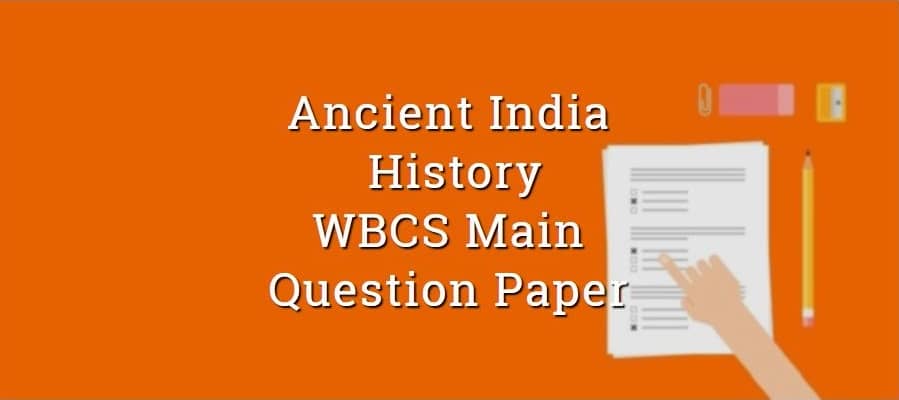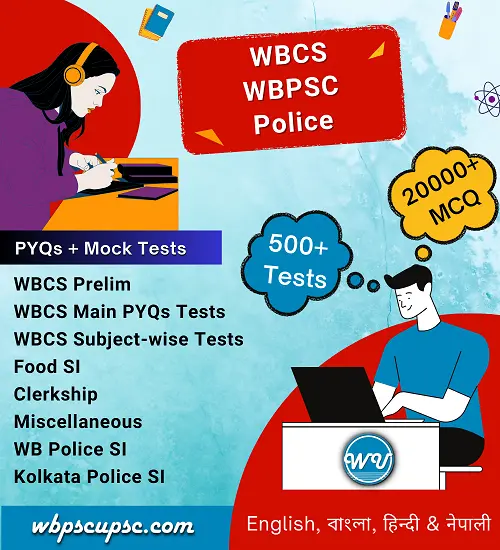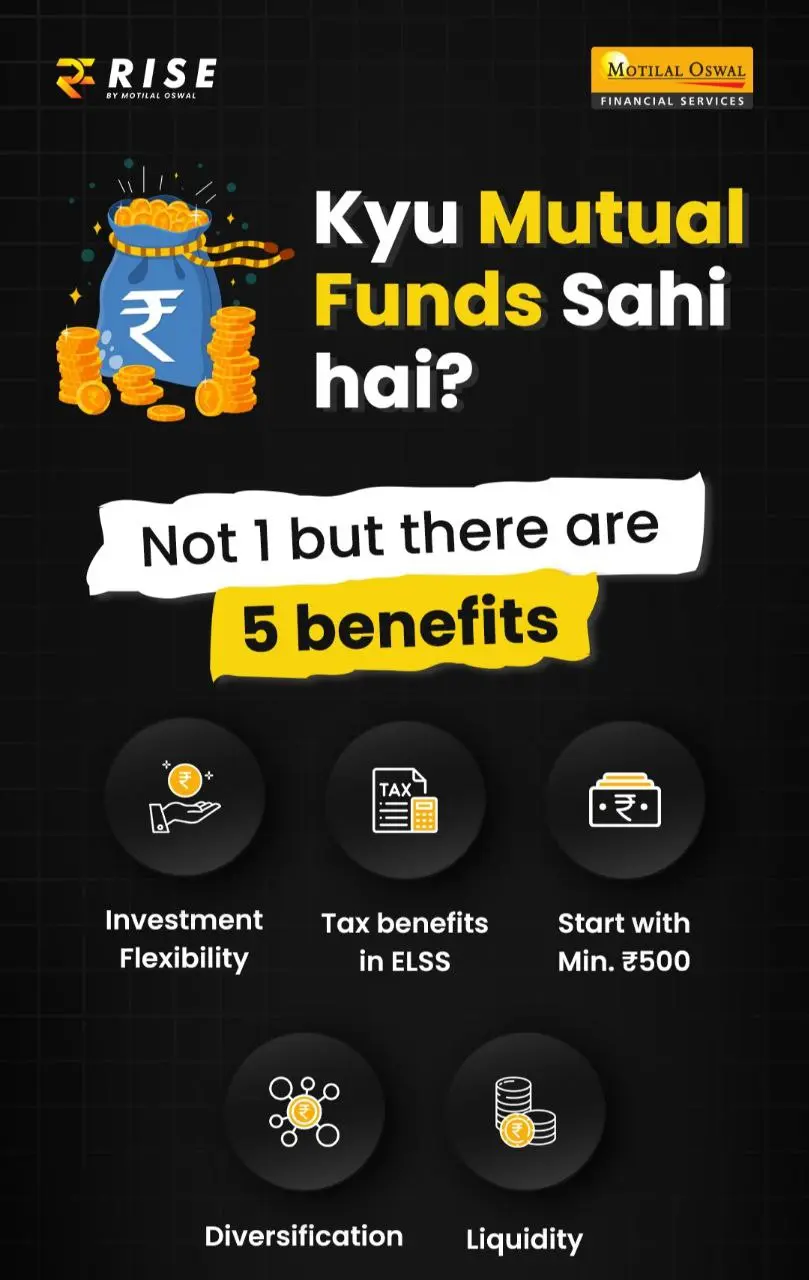wbcs main ancient history questions
WBCS Main Question Paper – 2022
- The “Three Jewels” are to be found in
(A) Vaishnavism
(B) Buddhism
(C) Judaism
(D) Jainism (Tri-Ratnas)
(Question canceled by PSC)
- The capital of the Magadhan Empire under Bimbisara was
(A) Girnar
(B) Girivraja
(C) Gauda
(D) Gujarat
- What was importance of Lothal?
(A) Port
(B) Granary
(C) Zoo
(D) Market
- The first ruler of the Pala Dynasty was
(A) Devpala
(B) Dharmapal
(C) Gopal
(D) Tejpal
- The Saka Era was started by
(A) Bimbisara
(B) Ajatasatru
(C) Kanishka
(D) Menander
- Karshapana was a type of
(A) Metal
(B) Paper
(C) Currency
(D) Race
- The Maurya Emperor who propounded the concept of “Dhamma” had been
(A) Chandragupta
(B) Bindusara
(C) Ashoka
(D) None of the above
- The last Buddhist Council was held at
(A) Sarnath
(B) Kundavalan
(C) Saket
(D) Ceylon
- The twenty third Tirthankara was
(A) Parshvanath
(B) Vardhaman Mahavira
(C) Gautam Buddha
(D) Ajatasatru
- The Vedas were
(A) Sacred Book of the Aryans
(B) Genealogical History
(C) Artefacts
(D) Language
- Bimbisara was from the
(A) Gupta Dynasty
(B) Haryanka Dynasty
(C) Maurya Dynasty
(D) Khilji Dynasty
- Where was the figure of the dancing girl to be found?
(A) Indus Valley
(B) Araku Valley
(C) Kashmir Valley
(D) Nubra Valley
- Who was known as the “Indian Napoleon”?
(A) Kumargupta
(B) Skandagupta
(C) Samudragupta
(D) Yasodharman
- The Kushanas were originally from
(A) Greece
(B) Iran
(C) Central Asia
(D) Europe
- The Allahabad Pillar Inscription dates back to the
(A) Maurya period
(B) Gupta period
(C) Kushan period
(D) Saka period
- The Battle of Hydaspes was fought between
(A) Bimbisara and Ajatasatru
(B) Bimbisara and Porus
(C) Porus and Alexander
(D) None of the above
- The first ruler of the Maurya Dynasty was
(A) Chandragupta Maurya
(B) Bimbisara
(C) Kanishka
(D) Megasthanes
- The book ‘Indica’ was written by
(A) Fa Hien
(B) Hiuen Tsang
(C) Megasthenes
(D) Asvaghosa
- The following was a Mahajanapada:
(A) Magadha
(B) Saurashtra
(C) Pragjyotishpur
(D) Sialkot
- Gautam Buddha was from the following clans:
(A) Vajji
(B) Sakya
(C) Kushan
(D) Saka
- The Garuda Pillar at Besnagar was endowed by
(A) Heliodorus
(B) Megasthenes
(C) Bimbisara
(D) Ajatasatru
- ‘Arthashastra’ was written by
(A) Chandragupta
(B) Bimbisara
(C) Kautilya
(D) None of the above
- The Buddha gave his first sermon at
(A) Gaya
(B) Sarnath
(C) Peshawar
(D) Karnataka
- Tamralipta was a
(A) River
(B) Canal
(C) Port
(D) Fort
- The Gupta Era starts from the reign of
(A) Chandragupta I
(B) Samudragupta
(C) Kumargupta
(D) Budhagupta
- The term “ Sakari” was used for
(A) Chandragupta II Vikramaditya
(B) Samudragupta
(C) Kumargupta
(D) Skandagupta
- The “Milinda Panho” was a
(A) Scripture
(B) Book on Philosophical discussion
(C) Artefact
(D) Cinema
- The last ruler of the Maurya Dynasty was
(A) Ajatasatru
(B) Bimbisara
(C) Brihadratha
(D) Kakavarna
- Sasanka was the ruler of
(A) Kanauj
(B) Pataliputra
(C) Gaur
(D) Assam
- The Central Asian theory of the home of the Aryans was propounded by
(A) Friedrich Max Muller
(B) Nirad Chaudhary
(C) Rakhaldas Banerjee
(D) Risley
- The Chinese pilgrim Fa Hien had visited India during the reign of
(A) Chandragupta II Vikramaditya
(B) Bimbisara
(C) Harshavardhan
(D) Kharvela
- The Eight-Fold path in Buddhism is known as
(A) Dharmachakrapravartana
(B) Ashtangik Marg
(C) Nirukta
(D) Vimukta
- The author of ‘Harshacharita’ was
(A) Nagarjuna
(B) Banabhatta
(C) Aryabhatta
(D) Varahamihir
- Mohenjodaro and Harappa belong to
(A) Egyptian civilization
(B) Sumerian civilization
(C) Mesopotamian civilization
(D) Indus Valley civilization
- Menander was a
(A) Kushan
(B) Indo-Greek
(C) Saka
(D) Chinese
- The oldest Veda was
(A) Rig Veda
(B) Sam Veda
(C) Atharva Veda
(D) Avesta
- The capital of Kanishka was
(A) Purushpura
(B) Sialkot
(C) Pathankot
(D) Bodhgaya
- The greatest Kushan ruler was
(A) Menander
(B) Gondophernes
(C) Maga
(D) Kanishka
- Who was known as “Beloved of the Gods”?
(A) Kalshoka
(B) Bimbisara
(C) Ajatasatru
(D) Ashoka
WBCS Main Question Paper – 2021
19. The river mentioned most frequently in the Rig Vedic hymns was
(A) Ganga
(B) Yamuna
(C) Sutlej (Satadru)
(D) Saraswati
35. Which Indian geographer had given information about Solar and Lunar eclipses?
(A) Aryabhatta
(B) Varah Mihir
(C) Brahmagupta
(D) Bhaskaracharya
39. Which ruler of Magadha was called ‘Amitrochates’ (Amitraghata – Slayer of Enemies) in Greek records?
(A) Bimbisara
(B) Ajatashatru
(C) Bindusara
(D) Asoka
43. The main sources of ancient Indian Geographical concepts are
(A) Hindu Mythology
(B) Travellers Account
(C) Sacred Laws
(D) All of the above
72. Ancient Indian Geography hinges on
(A) Systematic Study
(B) Observation
(C) Religion
(D) Scientific Laws
161. Which of the following statements is true of the Harappan civilisation?
(i) Harappan civilisation comprised of a network of urban constellations, drawing on the agricultural surplus generated by the surrounding countryside.
(ii) The Harappans seem to have flourishing trade relation with Sumeria and Egypt.
(iii) The seals are suspected to be connected with trading activities of the Harappans.
(iv) Overland trade rested primarily on bullock and horse-drawn carriages.
(v) Some deities akin to the mothergoddess and Pashupati seem to have been popular.
(A) (i), (ii), (iii)
(B) (i), (ii), (iii), (v)
(C) (ii), (iv), (v)
(D) (iii), (iv)
176. Which is our earliest source for the existence of untouchables in India?
(400–350 BCE)
(A) Atharva Veda
(B) Chandogya Upanishad
(C) Panini’s Ashtadhyayi
(D) Harshacharita
182. What were villages granted to Brahmins and inhabited by Brahmins known as?
(A) Devadana
(B) Brahmadeya
(C) Agrahara
(D) Mangalam
WBCS Main Question Paper – 2020
2. What is the meaning of the word ‘Sangam’ in the Sangam Age?
(A) Royal Court
(B) Assembly of Poets
(C) Assembly of religious teachers
(D) Meeting of rivers
3. Who composed the Sanskrit kavya ‘Saundarananda’?
(spiritual adviser of Kanishka)
(A) Asvaghosa
(B) Kalidasa
(C) Nagarjuna
(D) Visnu Sharma
5. Rulers of which dynasty patronised Jainism?
(6th – 12th century)
(A) Chalukya
(B) Pallava
(C) Rashtrakuta
(D) Chauhan
14. The learned lady who is said to have debated with the famous law-giver Yajnavalkya was
(9th – 7th century BCE)
(A) Gargi
(B) Maitreyi
(C) Kamala
(D) Kalindi
15. The river Chenab was known in the Vedic period by the name of
(A) Asikni
(B) Purushni
(C) Vitasta
(D) Shutudri
18. What was the ‘Araghatta’?
(A) A machine to break forts
(B) An irrigation canal
(C) A device to lift water
(D) A type of cloth
28. Which of the following statements is incorrect about the position of women during the age of Buddha?
(A) The position of women generally deteriorated
(B) There were several instances of child marriages.
(C) Polygamy was gradually growing among the ruling classed.
(D) Education was denied to women.
32. Which of the following was the basic unit of Vedic society?
(A) Jana
(B) Vidatha
(C) Parivar
(D) Sangh
41. Who was the most important God in the Rigveda?
(A) Agni
(B) Indra
(C) Varun
(D) Vishnu
43. Who among the following scholars declared that the ‘Saptsindhava’ region was the homeland of the Aryans?
(A) Dr. A. C. Das
(B) Prof. Max Muller
(C) Prof. Karl Penta
(D) Dr. K. K. Sharma
47. The Nayanar group of saints in North India were devotees of Lord
(A) Vishnu
(B) Shiva
(C) Krishna
(D) Buddha
53. Which of the following is the biggest Harappan civilization site?
(A) Ropar
(B) Lothal
(C) Kalibangan
(D) Rakhigarhi
60. The river most mentioned in the Rigveda is
(A) Sindhu
(B) Shutudri
(C) Saraswati
(D) Gandaki
61. “The most unique feature of this site is its dockyard; the world’s first tidal port, which served as a main seaport for the Indus people”.
The above statement holds true for which site?
(A) Ropar
(B) Lothal
(C) Rakhigarhi
(D) Banawali
64. The word ‘Veda’, derived from ‘Vid’ refers to
(A) Knowledge
(B) Energy
(C) Truth
(D) Karma
71. Which dynasty ruled over Magadha after the Mauryan dynasty?
(A) Satavahana
(B) Sunga
(C) Nanda
(D) Kanva
72. Which particular city became the nodal point for trade routes running from north to south and east to west in the pre-Gupta and Gupta periods?
(Madhya Pradesh)
(A) Taxila
(B) Mathura
(C) Ujjain
(D) Vidisa
76. Vedic literature is also known as
(A) Shruti
(B) Smriti
(C) Sanhita
(D) Vedanga
77. The Indian who was involved in the excavations of Harppa and Mohenjodaro is
(1922)
(A) S.D. Rathore
(B) K.K. Menon
(C) R.D. Banerjee
(D) R.D. Sharma
83. Kalibangan is located at
(A) Gujarat
(B) Rajasthan
(C) Himachal Pradesh
(D) Punjab
86. When and by whom were the Ashokan Inscriptions deciphered for the first time?
(A) 1787 – John Tower
(B) 1810-Harry Smith
(C) 1825 – Charles Metcalfe
(D) 1837 – James Prinsep
WBCS Main Question Paper – 2019
(plough – Kalibangan)
(A) Discovery of a dockyard
(B) Rectangular and circular fire alters for animal sacrifice
(C) Depiction of a ship on a seal
(D) Evidence of the use of the plough
(5th century BCE)
(A) Purana Kassapa
(B) Pakuddha Kaccayana
(C) Makkali Gosala
(D) Alita Keshakambalm
(A) Spasas
(B) Dutas
(C) Orrars
(D) Sanjayans
(A) Being cultivated and uncultivated
(B) Being irrigated and unirrigated
(C) Crops being grown on the lands
(D) All of the above
(A) Pallava
(B) Chola
(C) Nagara
(D) Dravida
WBCS Main Question Paper – 2018
54.
Alvar was _____ hymnodist of the Tamil devotional cult.
(A) Shaivite
(B) Vaishnavite
(C) Buddhist
(D) Jam
(Afghanistan)
(A) Shortugai
(B) Musa Khel
(C) Mundigak
(D) Damb Sadat
a) Aramaic
b) Greek
c) Brahmi
d) Both Aramaic and Greek
a) The Cheras of Vanji
b) The Cholas of Uraiyur
c) The Pandyas of Madurai
d) All of the above
a) all the lands donated were not secular land grants.
b) the status of the peasants was not that of serfs.
c) the brahmin donees did not always belong to the ruling class.
d) All of the three above
WBCS Main Question Paper – 2017
(published in 1961)
(A) D. N. Jha
(B) Romila Thapar
(C) R. S. Sharma
(D) A. L. Basham
(634)
(A) Ravikirti
(B) Harisen
(C) Bilhan
(D) None of the above
(A) Chandragupta Maurya
(B) Chandragupa I (Gupta)
(C) Chandrasen
(D) Chandragupta II (Gupta)
(1826)
(A) M. S. Vats
(B) M. Wheeler
(C) B. B. Lal
(D) Charles Mason
(483 BCE & 467 BCE)
(A) Bimbisara
(B) Ajatasatru
(C) Udayin
(D) Dasratha
(5th century BCE)
(A) Purana Kassap
(B) Pakudha Kaccayana
(C) Makkaii Gosala
(D) Ajit Kesakambalin
(Gopuram – Dravidian architecture)
(A) Stupa
(B) Gopuram
(C) Vihara
(D) Chaitya
(around 10,000 BCE)
(A) Palaeolithic
(B) Mesolithic
(C) Neolithic
(D) Harappan
(A) Egyptian
(B) Mesopotamian
(C) Harappan
(D) Mehargarh
(A) 2200 BC
(B) 2100-2000 BC
(C) 2000-1900 BC
(D) 1800-1750 BC
(A) Agni
(B) Indra
(C) Vishnu
(D) Shiva
(A) Anga
(B) Magadha
(C) Vanga
(D) All of the above
(A) Ganga
(B) Saraswati
(C) Sindhu (Indus)
(D) Yamuna
(A) North India
(B) Godavari valley
(Q Malwa plateau
(D) North-West frontier of the subcontinent
(A) Birth
(B) Death
(C) Enlightenment
(D) Renunciation
(A) Goat
(B) Pig
(C) Horse
(D) Dog
(35,000 to 3,000 years ago)
(A) Paleolithic Age
(B) Mesolithic Age
(C) Neolithic Age
(D) Chalcolithic Age
(7000 BCE)
(A) Mehargarh
(B) Amri
(C) Kalibangan
(D) Dholavira
(Etah district, bank of Kali river)
(A) Bihar
(B) Madhya Pradesh
(C) U.P.
(D) Gujarat
(A) Sungas
(B) Kushanas
(C) Indo-Greeks
(D) Vakatakas
(A) Fa-Hien
(B) Hiuen Tsang
(C) Yijing
(D) Arrian
(A) Krishna Yajurveda
(B) Atharva Veda
(C) Sama Veda
(D) Purusha Shukta
(A) Potwar plateau in Pakistan
(B) Hungsi Valley (Karnataka)
(C) Didwana (Rajasthan)
(D) Bhimbetka (M.P.)
(A) Brahmi
(B) Harappan
(C) Prakrit
(D) Devanagari
26. In
the Buddhist context, which one refers to texts that are supposed to contain what the Buddha himself said ?
(A) Sutta
(B) Vinaya
(C) Abhidhamma
(D) Milindapanha
(A) two
(B) three
(C) four
(D) six
(Lumbini, Nepal )
(A) Birth
(B) Enlightenment
(C) First Sermon
(D) Death
(A) Kalidasa
(B) Bhasa
(C) Ashvaghosha
(D) Kalhan
(A) Vesara
(B) Dravida
(C) Nagara
(D) Gopuram
(1097-1230)
(A) Senas
(B) Palas
(C) Rashtrakutas
(D) Pratiharas
(606-647)
(A) Varmans
(B) Maukharis
(C) Pushyamitras
(D) Pushyabhutis
(A) Gopal
(B) Dharmapal
(C) Vijayasena
(D) Ballalasena
(A) Kumargupta I in 324 CE
(B) Srigupta in 309-10 CE .
(C) Chandragupta l in 319-320 CE
(D) Samudragupta in 324 CE
(A) Manu
(B) Fa Hien
(C) Hiuen Tsang
(D) Narad
(A) Skandagupta
(B) Buddhagupta
(C) Purugupta
(D) Kumaragupta l
(A) Vikramaditya I
(B) Pulakesin I
(C) Pulakesin ll
(D) Vikramaditya II
(A) Kosala Kingdom
(B) Asmaka Kingdom
(C) Vatsya Kingdom
(D) Magadha Kingdom
WBCS Main Question Paper – 2016
(A) Porus (Puru)
(B) Ambhi
(C) Abhisara
(D) None of these
(A) Herodotus
(B) Megasthenese
(C) Fa Hien
(D) Yijing
(A) 800 BCE
(B) 500-400 BCE
(C) 300 BCE-200 CE
(D) 200 CE
(303 BCE)
(A) Mahapadma Nanda
(B) Chandragupta Maurya
(C) Bindusara
(D) Asoka
5. Name the historians who have rejected the idea of a marriage alliance between Chandragupta Maurya and Seleucus –
(A) Vincent Smith
(B) H.C. Roychoudhury
(C) H P. Shastri
(D) B. N. Mukherjee and Romila Thapar
(302-298 BCE)
(A) Diodorus Siculus – Bibliotheca Historica
(B) Strabo – Geography
(C) Anrian – lndica
(D) Claudius Aelianus – Naturalis Historica
7. Which of the following
major rock edicts of Asoka are in Prakrit language and Kharosthi scrips ?
(A) Manshera
(B) Shabbazgarbi
(C) Both (A) and (B)
(D) Dhauli
(A) Gopala
(B) Mahipala
(C) Devapala
(D) Dharmapala
(543 CE)
(A) Vikramaditya I
(B) Pulkesin I
(C) Kirtivarman I
(D) Vijayaditya
(9th century)
(A) Rashtrakuta
(B) Chola
(C) Pala
(D) Pratihara
(A) Saptadvipa
(B) Bharatvarsha
(C) Jambudvipa
(D) Both (A) and (B)
(A) Naqsh-e-Rustam
(B) Persepolis
(C) Behistun
(D) Hamadan
(A) BCE 200 – 300 CE
(B) CE 300 – CE 600
(C) CE 300 – CE 800
(D) CE 600 – CE 1300
(1,250,000 km2)
(A) The Harappan civilization
(B) Egyptian civilization
(C) Mesopotamian civilization
(D) Roman civilization
(A) R.E.M. Wheeler
(B) Bridget Allchin
(C) Raymond Allchin
(D) J.M. Kenoyer
(A) Ujjaiyini
(B) Taxila
(C) Tosali
(D) Tambaparini
(A) Ajivika monks
(B) Jain monks
(C) Brahmnas
(D) Shri Lankan Buddhist monks
(A) Harappan
(B) Later Vedic
(C) Maurya
(D) Kushana
(A) Tamralipti
(B) Muziris or Mushri
(C) Arikamedu
(D) Kaveripattanam
(A) Augustus
(B) Claudius
(C) Trajan
(D) Nero
(A) Gordon Childe
(B) Shereen Ratnagar
(C) R.S. Bisht
(D) Asco Parpola
A) Chakrapanidatta
(B) Sayana
(C) Kannada
(D) Sagarnandin
(A) Sudas
(B) Divodasa
(C) Atri
(D) Gritsamada
(A) Vitasta
(B) Asikni
(C) Parushni
(D) Sutudri
(A) The Purusha-sukta of the Rig Veda Samhita
(B) Yajur Veda Samhita
(C) Katbopanishada
(D) Manu smriti
(A) Vajjis or Vrijis
(B) Kosal and Vatsa
(C) Avanti and Magadha
(D) All listed in (B) and (C)
(A) North India
(B) The Deccan
(C) Both North India and Deccan
(D) Chola dynasty
47. Which
school of Art flourished in the region between the lower valleys of Krishna and Godavari during 2nd Century BCE – 3rd Century CE ?
(A) Gandhara School
(B) Mathura School
(C) Nagarjuna School
(D) Amaravati School
(A) Medicine
(B) Metallurgy
(C) Mathematics
(D) Astronomy
(A) Vakatakas
(B) Guptas
(C) Pallavas
(D) Chalukyas
(A) Anantavarman
(B) Mihirkula
(C) Yasodharman
(D) Toramana
(1500-1000 BCE)
(A) The Rigveda consists of 1028 hymns (Suktas)
(B) The Rigveda is divided into ten books (mandalas) of unequal sizes.
(C) The Rigveda is a monolithic text.
(D) The Rigveda is, not a monolithic text and consists of several literary layers.
(A) Anga (Eastern Bihar)
(B) Magadha (Southern Bihar)
(C) Vanga (in the Ganga delta)
(D) All of the above
(A) Bimbisara
(B) Ajatasatru
(C) Prasenjit
(D) Sisunaga
WBCS Main Question Paper – 2015
(A) Indra
(B) Agni
(C) Varuna
(D) Soma
(A) Samiti
(B) Sabha
(C) Gora
(D) Vidata
163. ‘House burials’ are reported from :
(A) Gufral in Kashmir
(B) Ghaligal – in the northeast
(C) Uleri in Almora
(D) Balathal in Rajasthan
(i) Gold and Silver
(ii) Cotton goods
(iii) Terracottas
(iv) Seals
(v) Pottery
Select the answer from the codes below
(A) ii, iii and v
(B) i, iii and iv
(C) i, ii, iv and v
(D) All of them
(A) MEM Wheeler
(B) Gordon Childe
(C) K. M. Srivastava
(D) S. R. Rao
(A) Northern most
(B) Southernmost
(C) Eastern most
(D) Western most
167. Which one of the following types of Harappan pottery is said to be the earliest example of its kind in the world ? (A) Polychrome
(B) Glazed
(C) Perforated
(D) Knobbed
(A) Sawn with the help of a saw-like instrument
(B) Made in an open mouId
(C) Hand-made
(D) Cut with the help of a chisel
(A) Bolan Valley
(B) Krishna Valley
(C) Godavari Valley
(D) Kashmir Valley
170. Which of the following is not a principal tool of the Early Stone Age ? (A) Scraper
(B) Handaxe
(C) Cleaver
(D) Chopper
(A) 451 AD
(B) 551 AD
(C) 615 AD
(D) 351 AD
(i) Abhigyana Sakuntalam
(ii) Meghadootam
(iii) Raghuvamsa
(iv) Malavikagnimitram
(v) Ritusamhara
(vi) Kumara Sambhava
Select the answer from the codes below –
(A) All of them
(B) i, ii, iii and iv
(C) i, ii, iv, v and vi
(D) i, iii, iv and v
177. Which one of the following was the meeting ground for the Brahmanical and devotional religious levels ?
(A) Maths
(B) Temples
(C) Ghatikas
(D) Samas
(A) Development of Science and technology
(B) Development of Arts and crafts
(C) Growth of Trade and commerce
(D) Increase in Agrarian surplus
180. Which one of the following has not been mentioned as ‘asineva’ in Ashokan inscriptions
(A) Greed and passion
(B) Cruelty and anger
(C) Pride and fury
(D) Envy and revenge
(A) Demetrius
(B) Antigonus
(C) Philadelphus
(D) Gondophernes
(A) Chandra Gupta Maurya
(B) Bimbisara
(C) Bindusara
(D) Asoka
183. ‘Just as for my children, I desire that they should enjoy all happiness and prosperity both in this world and the next. So for all men I desire the like happiness and prosperity’. This is stated in – (Major Rock Edict 13)
(A) Barabar Cave Inscriptions
(B) Minor Rock Edicts
(C) Tarai Pillars
(D) Kallinga Inscriptions
(A) Siva
(B) Vishnu
(C) Vasudeva
(D) Buddha
(Sandrakottos)
(A) Kautilya was Chandragupta’s guide and mentor
(B) Chandragupta was succeeded by his son Bindusara
(C) Chandragupta was known to the Greeks as ‘Amitrochates’, the destroyer of foes
(D) Chandragupta is said to have died of slow starvation in south India
(A) Puranas
(B) Jatakas
(C) Purvas
(D) European Classical Writers
(A) Kalahana’s Rajtarangini
(B) Divyavandana
(C) Taranatha’s History of Tibet
(D) Mahavamsa
(A) Megasthenes
(B) Diodorus
(C) Deimachus
(D) Dionisius
(A) Royal treasuries
(B) Civil courts
(C) Criminal courts
(D) Police stations
(A) Bhritakas
(B) Maula
(C) Vardhaki
(D) Aravivala
WBCS Main Question Paper – 2014
(A) Bhaja
(B) Bhimbetka
(C) Bagor
(D) Ajanta
(A) Manu
(B) Narada
(C) Brihaspati
(D) Parasara
(A) Pictographs
(B) Aramaic
(C) Sanskrit
(D) Brahmi
(A) Artisans
(B) Traders
(C) Cultivators
(D) Philosophers
(A) Sataman
(B) Dinara
(C) Muhara
(D) Varaha
(A) Sanskrit
(B) Pali
(C) Prakrit
(D) Bengali
(A) Divyavadana
(B) Rajatarangini
(C) Taranath’s History of Tibet
(D) Mahavamsa
(Lumbini, Nepal)
(A) Birth
(B) Enlightenment
(C) First Sermon
(D) Death
(A) Vishnu Purana
(B) Vayu Purana
(C) Markendaya Purana
(D) Matsya Purana
(A) Inscriptions
(B) Coins
(C) Manuscripts
(D) Relics
(A) The Mauryas
(B) The Kushanas
(C) The Greeks
(D) The Cholas
(A) A Parthian king
(B) A Bactrian Greek King
(C) A Saka King
(D) None of the above
(A) Asvaghosha
(B) Nagarjuna
(C) Basumitra
(D) Nagasena




